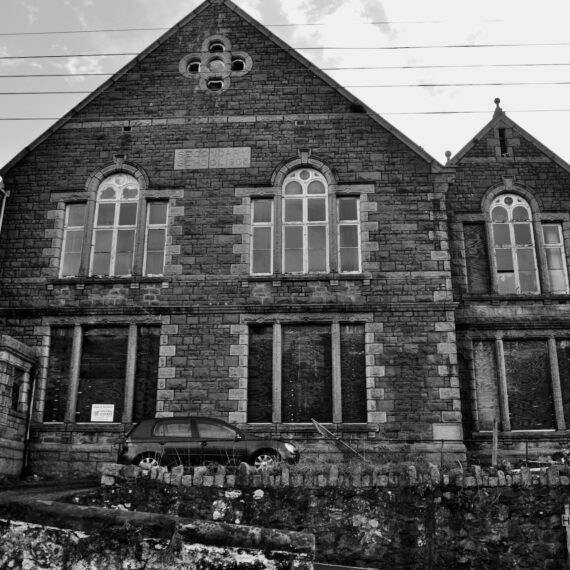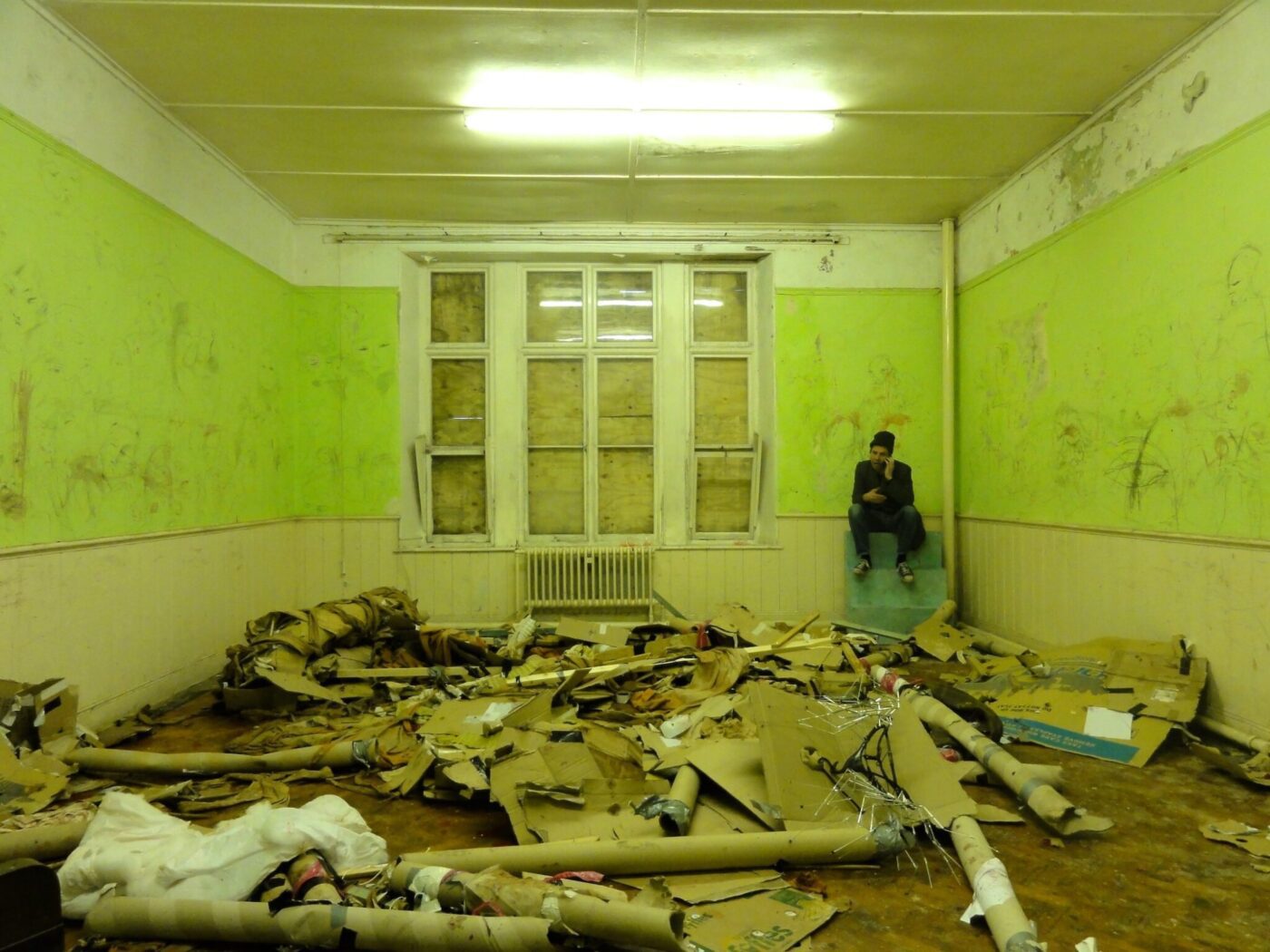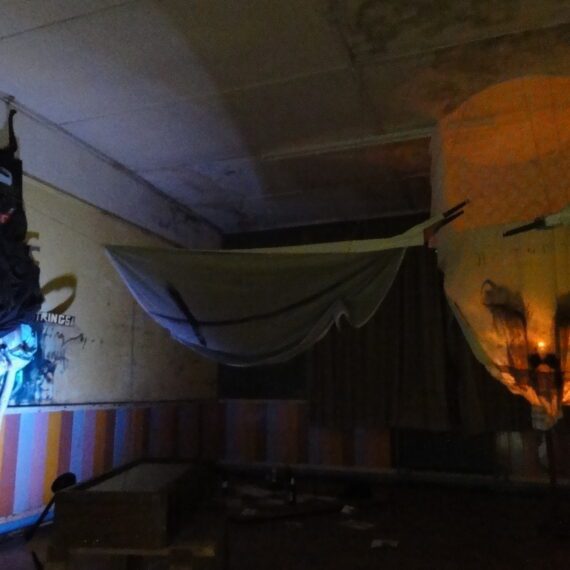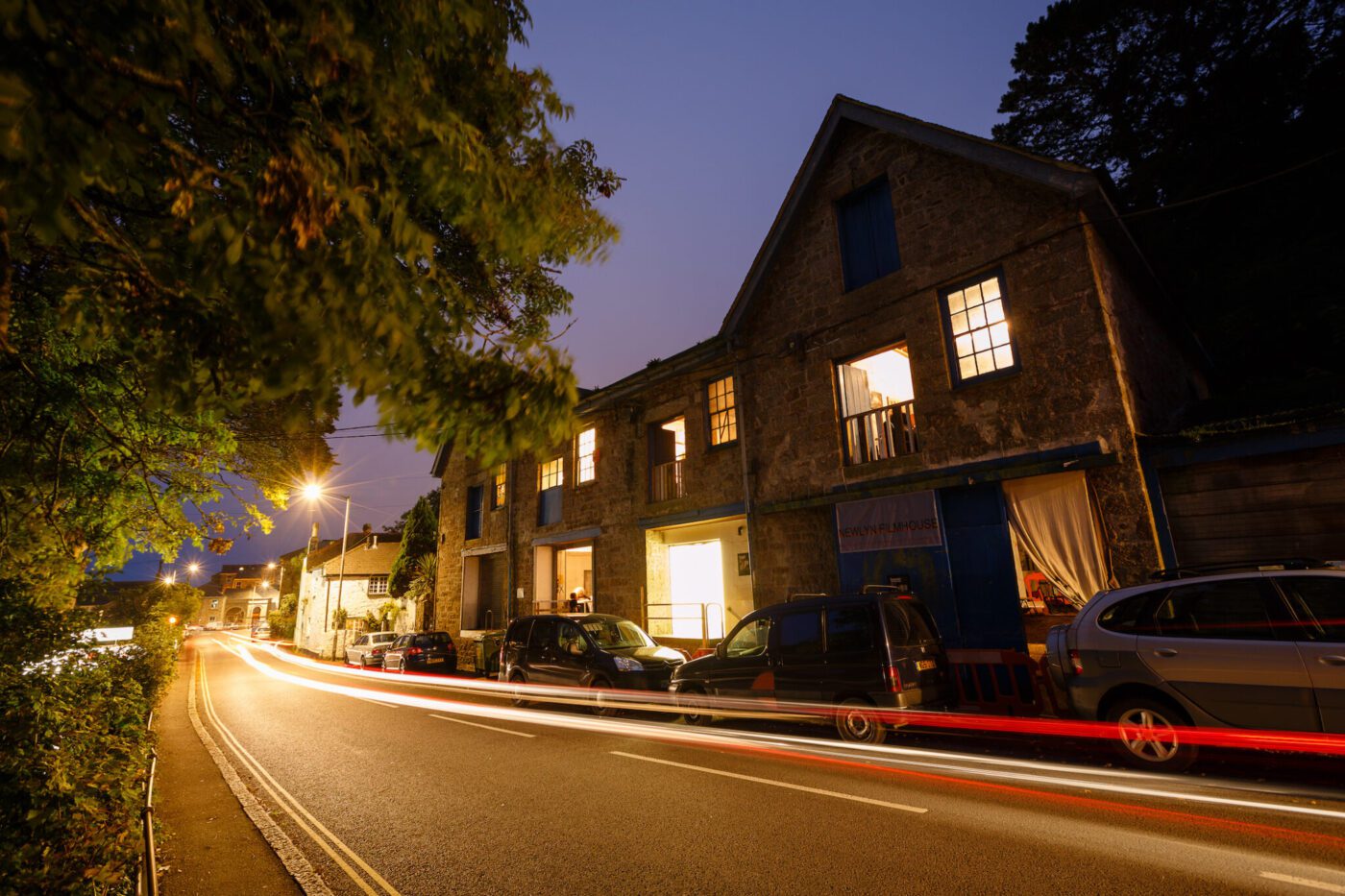Text: Unstable Monuments 2016
ART CAN CREATE MORE SPACE THAN CURRENTLY EXISTS.
THE OFTEN PHYSICALLY ROBUST AND COSTLY MATERIAL OF MONUMENTS DEFENDS THEM AGAINST TIME AND DESTRUCTION, BUT THE INTENTION OF ETERNITY MASKS INSECURITY.
A MONUMENT CAN BE SEEN AS AN INFLEXIBLE STATE OF MIND.
FROM THIS WE CAN SEE HOW MUCH WE LACK A PERSONALLY DEFINED SPACE WITHIN THE ‘PUBLIC’ ARENAS OF THE CITY AND ASK OURSELVES ABOUT THE ILLEGAL NATURE OF TRYING TO RECLAIM IT.
STREET SKATEBOARDING AND GRAFFITI ‘BOMBING’ SHOW THE POTENTIAL TO REDEFINE THE PRE-EXISTING FORMAT OF THE CITIES SKIN.
INERT CONCRETE IS ANIMATED BY LEGALLY REJECTED CARESSES, BODILY ABRASION IS MATCHED BY MATERIAL EROSION, AND THE FIXED MONUMENT, NO MATTER HOW ‘GREAT’ IT MAY SEEM, IN FACT, BECOMES TOTALLY UNSTABLE AND UNFIXED.
FOR SPACES TO REMAIN HABITABLE, THEY MUST BE SUBJECT TO CONSTANT CHANGE.
‘SOME’LL GO OF THEY OWN FREE WILL TO DIE / OTHERS TAKE THEM WITH YOU WHEN THEY BLOW SKY HIGH
/ WHAT’S THE DIFFERENCE? ALL YOU GET IS LOST CHILDREN.’
‘STRANGE WAYS’ / MF DOOM / MADVILLAINY
A CHILD MAKES A SPACE OUT OF BEDSHEETS IN ORDER TO PLAY, SERIOUSLY. DEFINE THE SPACE / RECONFIGURE THE RULES / ESTABLISH THE TOOLS
IN MALAGASI CULTURE DURING THE FIRST YEAR AFTER A LOVED ONES DEATH IT IS NOT UNCOMMON FOR THE BODY TO BE INTERMITTENTLY EXHUMED FOR A PARTY WHERE RELATIVES DANCE WITH THE BODY.
By Matthew Benington
‘From Ireland, London, Cornwall, Copenhagen, Cologne and Berlin, we all grew up surrounded by monuments of former, now defunct industries. Rather than commiserate these monuments as potential losses, it made more sense for us to utilise and re‐engage them with fresh function. The cultural processing of ruins can only be aided by this process. For spaces to remain habitable they must be subject to change. Inner city architecture risks monument status, when it cannot be touched, tampered with, changed, or even seen through.’
Matthew Benington.
Curated by Matthew Benington, Jesse Leroy Smith and Sam Bassett
Funded by the Arts Council England. The Old Bakery Studios, Truro, UK
14 artists from London, Germany, Denmark and Cornwall whose practice employs painting, installation, quilt making, film, shoemaking, posters and print. An immersive transformation of an ex-industrial warehouse sees these artists exploring dissolution and change within society’s structures and touchstones with reference to faith, gender, architecture, migration, anthropology, family, dance and ritual.
A monument can be seen as an inflexible state of mind. How might we realise more fluid and appropriate ways to commemorate what we value and admire.
Cornwall offers the curators the ideal environment to launch ‘Unstable Monuments’. With the mining legacy permeating a vital and raw landscape, it’s building and sites are latent with possibility.
With the show evolving this year to be taken to other sites (Cologne, Amsterdam, Brighton) the team sees the region as the perfect breeding ground for their approach to exhibiting. Through collaboration with public partnerships, reclamation of civic space and re-invention of redundant buildings the show can be a catalyst for change. The three curators have an intimate knowledge of the county. At Falmouth University, Benington studied Fine art, Smith has lived in Penwith for 15 years and Bassett is born and bred in St Ives. All three have a commitment to the future of Cornwall. The momentum for this landmark show comes from a succession of immersive multi-media shows curated by Smith. The ‘Darkrooms’ at CAST, Helston 2013 in a boarded up Victorian school helped launch the Arts Hub, ‘Revolver’ in an ex-car-showroom, now a gallery and Art 75 in the Jubilee Lido both in Penzance and ‘Suspended Sentences’ in a Newlyn fish factory now to be an Art a house cinema.
These shows brought together large collectives of artists, performers, educational organisations and the wider public to fully exploit the potential of the time and building. Students to artists with international reputations worked together to present ambitious artworks that can re define the reputation of the visual arts in Cornwall.
When Bassett instigated the show ‘Limbo’ in an ex-coffin store in Truro in 2013 a fruitful partnership began with those developing the Truro festival. Neil Scott (Totally Truro) and the festival team have enabled the artists to fully engage with the wider public and make this project happen. The Old Bakery Studios is a large historic waterside building and the managers Nigel and Catherine King have kindly offered the artists the 8,000 square foot currently undeveloped ground floor space to work and present the show. The curators hope to profile the vision of Old Bakery Studios as a multi-purpose venue hosting art and music events, creative workspaces and studios, café and bar. The curators want to harness and celebrate the generosity of spirit and tenacity of these partners.
Taking this model of spontaneity, camaraderie and determination this show explores how our challenges can be confronted and reevaluated. Communities and displaced peoples, family structures and ancestries, faith and cultural icons are the fabric of this show. The Curators will be hosting the 2-day event and with exhibition tour (see above) they welcome the opportunity to discuss any ideas and feedback.
“Turn and face the change, ch,ch ch changes …” David Bowie RIP
“Pliancy and weakness are expressions of the freshness of being. Because what has hardened will never win.’ Andrei Tarkovsky.
The Works
Matthew Benington has been developing dialogue with the artists as a means to explore his ideas about the Monument. His Hide series consists of a bespoke architectural structure that can be both an intimate gallery space and a studio. In this manifestation Hide will be a monument to displaced people and their photographs. This is a response to a perceived lack of public monuments dedicated to remembering people who have suffered the hardship of diaspora and the loss of their home. The Hide will be lined with 25 square meters of steel etching plates. In 2013 he made studio visits to Cologne, Wuppertal, and Berlin in order to see the studios of the exhibiting German artists who had all grown up in the Ruhr, surrounded by monuments of former industry.
A ceramic mask made by Andreas Gloel brings to mind the Imperialist consumption of African art by the West, as he incorporates the presentation of the works in bolts through the ears of the design itself. Familiar objects become uncanny, when the artist employs hand-stitched shoe-making processes to create a perfectly un-wearable, circular leather object.
The stitch is a vital tool for Leon Matis Robin Monies’ Comfort series. Made out of sewn-together props, insignia and symbolic objects, the series utilises the language of different hierarchy-based societies. These garments originally earned by labour to define rank and status. In this new paradigm, communities and social institutions are completely mixed up, pointing to a society where an individual creates their own rules, status and value systems.
Kathryn Ferguson embraces the legacy of the Riot Grrrl movement – and its influence on modern activist groups like Pussy Riot – with a film that explores punk’s connection with protest. ‘Rear Guard’ challenges the over-sexualisation of young women in music videos. ‘Máthair’, Irish for Mother, is an exploration of the religious and cultural rituals experienced firsthand by the filmmaker. This film, prompted by and realised through a holy pilgrimage with her mother, recognises and celebrates the need to revisit the rituals of the artist’s past. ‘Máthair’ presents a hyperreal vision of Ireland conveyed through patterns of thought, memory and behaviour that map the artist’s own construction of her homeland.
Jesse Leroy Smith’s large scale triptych paintings collage cultural heroes with family ‘members’ and intimately known land with once visited or never seen places. Inviting close friends to render the under-painting that frequently re-surfaces and his children to better describe creatures or animalistic performers. The ensuing images jar and meld into what needs to be a beguiling translation of the ancestry and identity of the maker/s.
Film-maker Roger Thorp has collaborated with Smith in film animations ‘Bardo’ and ‘Blood to dust’ where ‘culturally over-loaded’ heads emerge and disintegrate in the painting process on copper. Thorp’s artistic practice often reflects on film scripts he has written, in this instance a road movie based on a Jean Renoir quote “the landscape that parades before us shapes us as much as our genes”. Thorp has rigorously re-edited the 7 animations of ‘blood to dust’ into a sole barrage of exquisite paint and light.
Dick Jewell has had a fixed lens on the flux of London Club and dance culture for the last 40 years. A space where religious fervour is reached (Rave + Breaks, 1992), difference is desired (Skins, 1978), and culture composts to form the new (Kinky Gerlinky). The Jazz Room, shot on Super 8, 1987, was about the development of jazz dance at the Electric Ballroom, Camden. At the start of each night ‘the film so far’ was projected above the dance floor, before continuing to shoot more material to incorporate into the film. This created an interaction between the dancers and the film that informed the development of the dance style.
Joe Drakeford’s mirrored perspex architectural models feature internally projected film of reflections observed on the skin of the real architecture they refer to. The seductive distortions of the defensive design trend, one-way mirror, which coats so much of the cities buildings, can’t shake off its former function, the paranoia of the interrogation room. By denying potential visitors truthful vision the architecture declines admittance and interaction, whereas internalising views of what a tower reflects endows a building with an otherwise sorely lacking human gaze.
Marianne Keating’s work explores different aspects of society’s private emotions. The project entitled Tell Me, began by placing a series of postcards with six different questions in various locations around London in doctors surgeries, dentists, cafes, pubs, libraries, etc. and the public were invited to respond anonymously to these postcards. The physical engagement of the public, who are an integral part of her practice, decide to secretly divulge their inner thoughts which are then projected back in a public sphere. Her practice is heavily weighted in text and her installations incorporate animated digital projections onto architectural facades and internal experiential environments. This interaction opens a dialogue between the participant and the viewer by taking these nameless voices and projecting them back into the environment.
Sam Bassett will be using the floors, walls, corridors and pillars of the building to make an expansive painting made on site to explore the perpetual fragility of the human mind as it processes the influences, experiences and responsibilities of daily life in a society fixated on ‘growth’.
Adam Hogarth will be showing the ‘Darts project’ looking into notions of impermanence and auto-destruction contained within the domestic photograph. Printed photographic images are partly destroyed using darts and bleach to heighten its contradictory nature.
Stephen Smith’s works is made through a visual language embedded in a process of construction and subsequent deconstruction. Through this process themes, forms and motifs are built up and re-worked over time, with each iteration new works are formed in which the dialogue is in a constant state of flux. The starting point for these works has stemmed from an interwoven paradoxical collection of narratives built from conspiracy theories, bit-rot and psycho geographic post traumatic landscapes. Recent work has largely focused on painting utilising formal abstraction based on a field trip he took as Artist in residence with the Unknown Fields Division (Architectural Association, London) to Chernobyl (The lost atomic city of tomorrow) and the Russian Space Centre in Kazakhstan.
The Artists
Matthew Benington based in Bath and London. Exhibited across UK and recently in Cologne, Germany. Residency in Alberta, Canada 2011. First class BA HONS, Falmouth University, 2010, MA in printmaking at the Royal College of Art 2010-2012. Saatchi New Sensations exhibition, London, 2010, Stanley Picker print fellow for Kingston University 2012-2013. http://www.matthewbenington.com/
Jesse Leroy Smith, Lives /works in Brighton and Penzance, Royal Academy schools 89-92. Established painter exhibiting in public and commercial galleries and international art fairs. Curating immersive shows in dis-used /ex industrial spaces with large body of artists/ performers and public gallery exhibitions e.g. PRINT! at the Exchange in Penzance. Visiting lecturer at Falmouth University, Current Commission for Cornish Mining World Heritage sties. https://jesseleroysmithstudio.com
Sam Bassett born and lives in St Ives, Studio at Porthmeor studios, co-curated ‘Limbo’ ex coffin store, Truro, set up Bucca gallery, Newlyn. Represented by Anima-Mundi gallery with international art fairs and solo shows.
http://www.anima-mundi.co.uk/samuelbassett/samuelbassett.htm
Dick Jewell filmed London music culture for 40 years, his work demonstrates the constant flux of this subject. Dick will contribute a film work. Recent shows include Postmodernism: Style and Subversion 1970-1990 V&A, London and Word Sound and Power at the O2, London.
Kathryn Ferguson is an Irish curator, artist and lecturer. She will contribute her films “Mathair” and “Rear Guard.” She has exhibited at the V&A, Pompidou Centre, and the BFI. http://www.kathrynferguson.co.uk
Andreas Gloel, has Graduated from the Dusseldorf Kunst Akademie. Cologne, co-founder of Bruch und Dallas gallery.
https://vimeo.com/57201771
Bernhard Holaschke, Wuppertal has shown work at the Hermitage St Petersburg, and collaborated with Matthew Benington in BURN, at Gold+Beton Gallery, Cologne. http://www.bernhardholaschke.de
Marianne Keating, RCA printmaking alumni, Ireland. Marianne will make a site-specific work by collecting town secrets in anonymous polls and projecting them onto the building. She has exhibited in London, Paris, New York, Melbourne and Shanghai. http://www.mariannekeating.com/gallery
Joe Drakeford works with installation, light projection, moving image, photographic collage and silkscreen printing, he graduated from the Royal College of Art in 2012, 2013 Drakeford was awarded the Royal British Society of Sculptors Bursary Award which resulted in an exhibition in the RBS Kensington gallery. He was also a semifinalist in 2012 for the Adobe Achievement Awards and short-listed for the 20/21 Art Prize.
http://www.joedrakeford.co.uk
Leon Matis Robin Monies b. Copenhagen, Dk. Live and works in London, UK.
Monies studied at Reitveld Akademie, Amsterdam, NL, Slade school of fine art, London, UK and G.A.F.A., Guangzhou, CH. Before studying he worked for artist Tal R for 3 years. Monies was in a Blain Southern group show recently and in 2014 he was the artist in residence at Bangkok University.
http://www.robinmonies.com
Adam Hogarth is an artist based in London, UK. 2013 Royal College of Art, MA in Fine Art Printmaking. Exhibited nationally and internationally, 2013 Bloomberg New Contemporaries at the ICA London and Spike Island, Bristol. Currently exhibiting at the ‘Art of Remembering’ exhibition at the Rheged Centre, Penrith.
http://adamhogarth.co.uk
Jack Davis based in St Ives, Cornwall. Graduated, Falmouth University, 2012, 3 solo shows nationally, exhibited internationally, including Scope Art Fair, Miami, PROTECHT in association with the Whitechapel Gallery, The Threadneedle Prize : Figurative Art Today, invited artist to Sculpture by the Sea, Cottesloe 14 Australia. Creating new site-specific work for the show where creation & destruction go hand in hand.
http://www.jdfa.co.uk
Roger Thorp Cornwall based artist working in film, music and poetry. Roger’s artistic practice is drawn from the European Cinema and rock poets of the latter half of the last century and expressed through a visual interpretation of his own poetry. Beyond Cornwall, his work has been exhibited in Barcelona, Rome, Istanbul, Bristol and London.
http://www.rogerthorp.net
Stephen Smith, visual artist based in Plymouth. Painting, drawing, print and installation. Exhibited his work internationally including: Baltic Centre for Contemporary Art, Nam June Paik Centre (South Korea) and MU (Netherlands). Artist in residence with the Unknown Fields Division (as above).
http://stephen–smith.com






